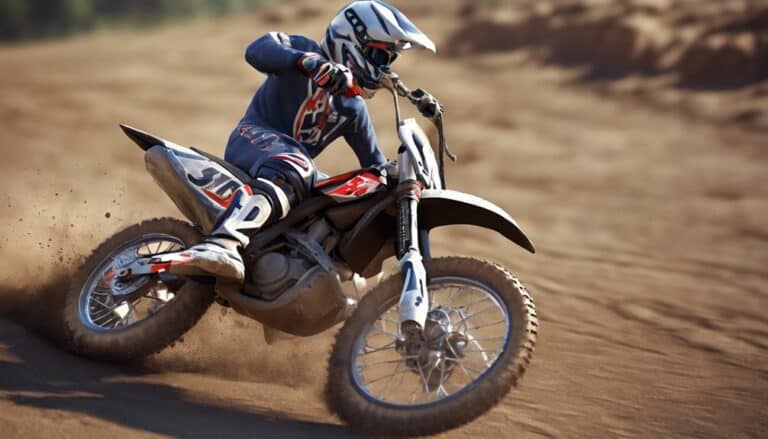You may think squeezing those brakes like you're in a Hollywood action scene is cool, but there's more to it than meets the eye.
Understanding the nuances of different dirt bike braking methods can make all the difference between a smooth ride and a potential disaster. From mastering the front brake to knowing when to apply the rear brake, each technique plays a critical role in your safety on the track.
So, before you hit the trails, make sure you've got a good grip on the dos and don'ts of dirt bike braking methods.
Key Takeaways
- Proper braking techniques ensure safety and control on dirt bikes.
- Front brake is crucial for stopping power; rear brake stabilizes and controls speed.
- Combination braking with front and rear brakes enhances efficiency and maneuverability.
- Emergency braking requires firm grip, weight distribution, and progressive front brake pressure.
Importance of Proper Braking Techniques
Mastering the proper braking techniques on a dirt bike is important for ensuring the best safety and control while riding. Your body position is vital when applying brakes; lean slightly back to shift weight onto the rear wheel for better traction.
Understanding the dynamics of braking is key – the front brake lever provides the majority of your stopping power, while the rear brake plays a supporting role in stabilizing the bike and controlling your speed. Proper braking technique not only shortens your braking distance but also maximizes traction, preventing skidding or loss of control.
Front Brake: Dos and Don'ts
Understanding the proper dos and don'ts of utilizing the front brake on your dirt bike is essential for enhancing safety and control while riding off-road. When it comes to front brake technique, do smoothly apply pressure to transfer weight forward and increase traction, allowing for controlled stops. Avoid abruptly grabbing the front brake lever, as this can lead to the front wheel locking up and a loss of control. It is vital to practice proper technique to build confidence and guarantee safety on the trails. While the rear brake is important, don't underestimate the significant contribution the front brake makes to efficient braking and quicker stops. Balancing caution with effective front brake dominance is key to stability and improved stopping power.
| Dos | Don'ts |
|---|---|
| Smoothly apply front brake for weight transfer and increased traction | Abruptly grab front brake lever |
| Practice proper technique for confidence and safety | Solely rely on the rear brake |
| Balance caution with front brake dominance for stability | Underestimate the importance of efficient front braking |
Rear Brake: Best Practices
To optimize control and stability while riding off-road, mastering effective rear brake techniques is essential. The rear brake on dirt bikes plays a pivotal role in maintaining control and slowing down when needed.
When approaching tight corners or tricky terrain, feathering the rear brake by gently applying and releasing pressure can help you adjust your speed without losing balance. Combining the rear brake with the front brake enables balanced braking, preventing skidding and allowing for controlled deceleration.
By practicing and refining your rear brake skills, you can improve rider confidence and safety on dirt trails. Remember, consistent use of proper braking techniques, including the rear brake, is key to enhancing your overall riding experience.
Combination Braking: When to Use
For optimal stopping power and control on dirt bikes, knowing when to engage combination braking is essential. When using the front brake, remember that it provides the majority of the braking power.
However, to maximize braking power and maintain stability, it's critical to also engage the rear brake. By smoothly applying both brakes simultaneously, you can achieve efficient braking while maintaining control over your bike.
Combining the front and rear brakes allows for quicker stops and better maneuverability, particularly in challenging trail conditions like steep descents or tight corners. Practice coordinating your brake inputs to enhance your braking skills and adapt to different terrains effectively.
Emergency Braking: Tips for Safety
During emergency braking situations on a dirt bike, maintaining a firm grip on the handlebars while applying both front and rear brakes is essential for safety and control. To execute emergency braking effectively, focus on distributing your weight evenly and keeping it low to enhance stability and avoid the risk of flipping the bike forward.
Utilize the front brake with progressive pressure on the lever to prevent locking the front wheel, ensuring you maintain control throughout the process. Simultaneously, engage the rear brake to assist in distributing braking force and prevent skidding.
It's vital to practice emergency braking techniques in a controlled environment to develop muscle memory, enabling quick and instinctive reactions in real-life scenarios. By honing these skills, you enhance your ability to react promptly and decisively during unforeseen circumstances, ultimately prioritizing your safety on the dirt bike.
Conclusion
In summary, remember that mastering dirt bike braking techniques is vital for preventing accidents and maintaining control.
So next time you're tearing up the trails, make sure to apply those brakes smoothly and prioritize the rear brake on wet surfaces.
And remember, skidding is for amateurs – real pros know how to brake like a boss.
Happy riding!

